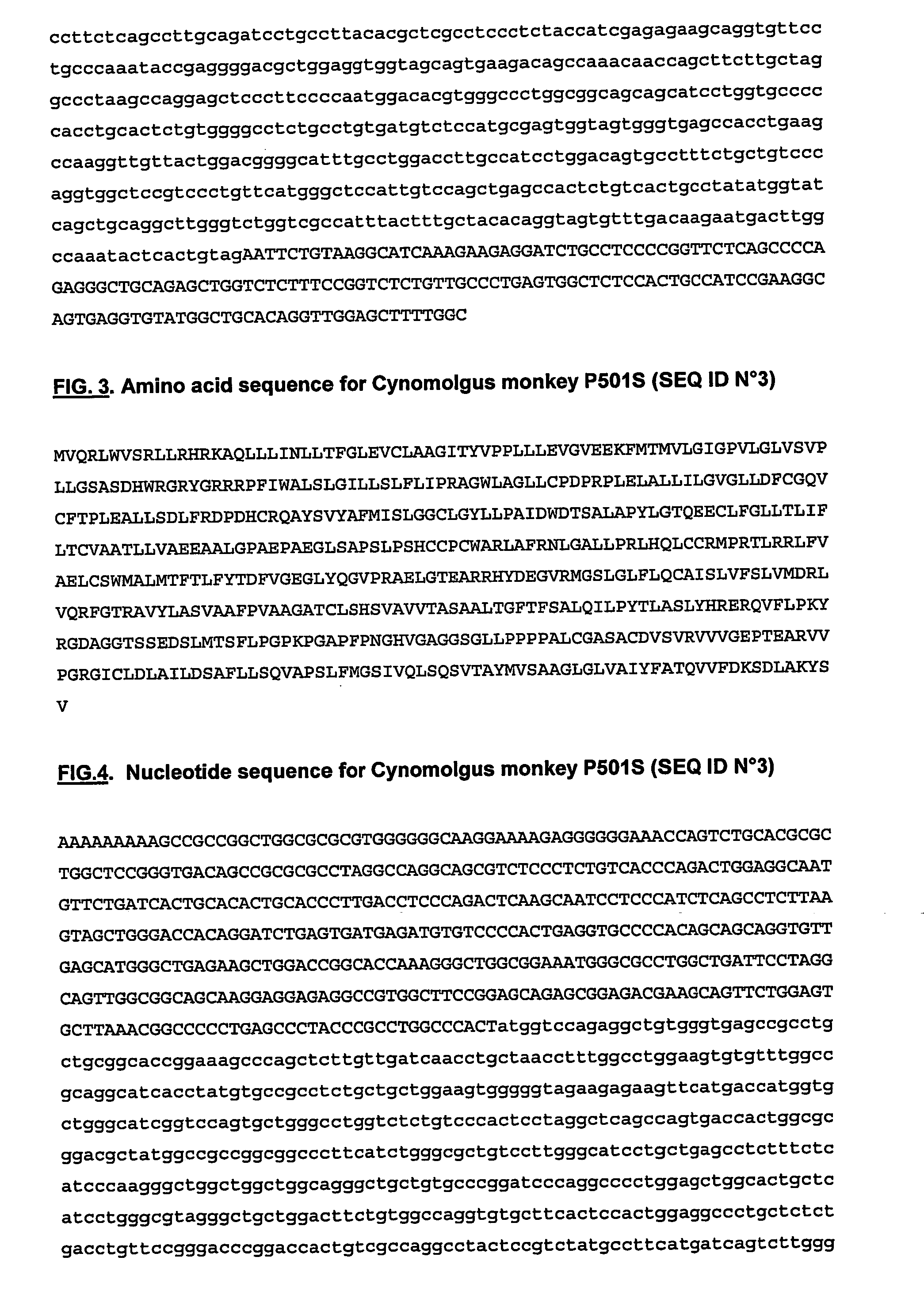Immunogenic compositions comprising a xenogenic prostate protein p501s
a technology of xenogenic prostate protein and composition, which is applied in the direction of drug composition, genetic material ingredients, antibody medical ingredients, etc., can solve the problems of increased patient mortality, ineffective methods, and difficult treatment of prostate cancer
- Summary
- Abstract
- Description
- Claims
- Application Information
AI Technical Summary
Benefits of technology
Problems solved by technology
Method used
Image
Examples
example i
Preparation of Recombinant Yeast Strain Saccharomyces cerevisiae Expressing Alphaprepro P501S His Tailed, Under Cup1 Promoter
1.—Introduction
[0103] The yeast expression system detailed below is suitable to express:
[0104] i) either recombinant non-human (monkey, rat, mouse for example) protein to be formulated subsequently in a vaccine or pharmaceutical / immunogenic composition to be inoculated into humans. Xenogeneic P501S can be expressed with its own signal sequence or with alpha prepro signal sequence (similarly to what is illustrated below).
[0105] ii) or recombinant human P501S protein to be formulated subsequently in a vaccine or pharmaceutical / immunogenic composition to be inoculated into animals (monkeys, rabbits, mouse or rat for example).
[0106] The Example below describes the expression of human P501S in yeast.
[0107] In order to target P501S protein in yeast endoplasmic reticulum (ER) membrane, the native secretion signal sequence and putative first lumenal domain was...
example ii
Expression and Characterization of Recombinant p501S Protein.
1.—Highlights
[0122] Using the process described below, the P501S antigen produced was clearly identified as a 62 KD major band by Western Blot analysis. The antigen productivity was compared by WB analysis and densitometry. The antigen was located in the insoluble fraction obtained from the cell homogenate after centrifugation. The specific antigen productivity of strain Y1790 in fermenters was approximately 4 times higher than in flasks. As the biomass was amplified by a factor 10 in fermenter, the volumetric productivity was about 40 times higher in fermenter compared to flask cultures. Strain Y1790 (his-) was grown in fed-batch fermentation using 20 L vessels.
2.—Process Description for Strain Y1790 (FIG. 10)
a. Pre-Cultures
[0123] 100 μl of this lab Master Seed (MS) containing 2.5×108 cfu / ml were spread on FSC004AA solid medium (see medium composition below). Two plates were incubated for 26 h at 30° C. These sol...
example iii
Compositions and Methods to Induce an Immune Response
A—Vaccine Preparation Using Xenogeneic or Human P501S
1.—Vaccine Preparation:
[0134] The vaccine used in these experiments is produced from a recombinant DNA, encoding a human or xenogeneic P501S recombinantly expressed in S. cerevisiae, either adjuvanted or not. As an adjuvant, the formulation comprises a mixture of 3 de-O-acylated monophosphoryl lipid A (3D-MPL) and QS21 in an oil / water emulsion. The adjuvant system SBAS2 has been previously described WO 95 / 17210.
[0135] 3D-MPL: is an immunostimulant derived from the lipopolysaccharide (LPS) of the Gram-negative bacterium Salmonella minnesota. MPL has been deacylated and is lacking a phosphate group on the lipid A moiety. This chemical treatment dramatically reduces toxicity while preserving the immunostimulant properties (Ribi, 1986). Ribi Immunochemistry produces and supplies MPL to SB-Biologicals. Experiments performed at Smith Kline Beecham Biologicals have shown that 3D...
PUM
| Property | Measurement | Unit |
|---|---|---|
| volume | aaaaa | aaaaa |
| temperature | aaaaa | aaaaa |
| volume | aaaaa | aaaaa |
Abstract
Description
Claims
Application Information
 Login to View More
Login to View More - R&D
- Intellectual Property
- Life Sciences
- Materials
- Tech Scout
- Unparalleled Data Quality
- Higher Quality Content
- 60% Fewer Hallucinations
Browse by: Latest US Patents, China's latest patents, Technical Efficacy Thesaurus, Application Domain, Technology Topic, Popular Technical Reports.
© 2025 PatSnap. All rights reserved.Legal|Privacy policy|Modern Slavery Act Transparency Statement|Sitemap|About US| Contact US: help@patsnap.com



